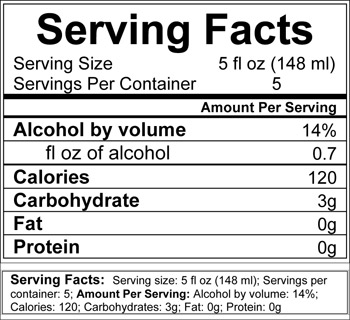For 10 years, consumer-advocacy groups, along with spirits, wine and beer giant Diageo, have lobbied the Alcohol and Tobacco Tax and Trade Bureau (TTB) to allow alcoholic beverages to bear a Serving Facts label. Following a Feb. 12 decision that flavored malt beverage Four Loko must disclose the amount of alcohol per serving and number of servings per container on its cans, supporters made a renewed appeal. On May 28, with TTB Ruling 2013-2, they got their wish.
The ruling, "Voluntary Nutrient Content Statements in the Labeling and Advertising of Wines, Distilled Spirits and Malt Beverages," allows producers to attach a label to their beverage stating serving size, servings per container and fluid ounces of alcohol per serving. Posting any of that information was previously illegal. Producers can also include nutritional information regarding calories, carbohydrates, fats and proteins per serving. A label may include serving information, nutritional information, both or neither, so long as alcohol by volume is still stated.
"It's a win for everybody," said Guy Smith, Diageo North America executive vice president. "There seems to be enormous flexibility provided by the TTB in terms of how [the information] is presented to the consumer. For our industry, it's a big advancement because heretofore, we actually were forbidden by law to put this data on our labels."
While the labels are voluntary, the TTB issues rulings as placeholder guidelines while hammering out regulations—and the regulation under consideration would make Serving Facts labels required. "We're OK with a voluntary labeling of Serving Facts for wine," said Wendell Lee, general counsel for the Wine Institute. "That would change if it became mandatory."
One concern is the real estate on the back of bottles. "The wine business is a very competitive business, and all they're doing is filling up the label to the point where there's no potential for any of us to market" information about the taste, terroir and food pairings, said Scott Osborn, owner of Fox Run Vineyards and president of the New York Wine Industry Association.
But the major fear is that mandatory labels would prove costly and burdensome for smaller wineries. While fats and proteins are negligible in wine, testing for calories and carbohydrates requires expensive equipment few small wineries can afford, and sending samples offsite racks up costs, especially for wineries that bottle small amounts of many different cuvées. "The calorie count is the real concern. Wine changes from bottling to bottling in a different way than some other items do," said Adam Lee, co-owner of Sonoma-based Siduri Winery and Novy Family Wines.
Especially in cooler climates, sugar and, thus, alcohol levels fluctuate from vintage to vintage, which affects this nutritional information. "If we had to update [the label] every year, it'd really be bad news," said Brian Loring, proprietor of Loring Wine Cellars, which has 17 different 2011 releases.
For now, small producers are simply taking a pass. "As long as it's voluntary I think it's a non-issue," said Jacob Fetzer, co-owner of Masút Vineyard.
Diageo has a much larger portfolio, and some of its brands fall under new or hybrid drink categories, like Smirnoff Ice, while some include unusual packaging, which could lead to consumer confusion over serving facts if unlabeled. "There are a lot of people who will say, big deal, and there will be other people who find the information incredibly valuable and useful," said Smith. The company is now evaluating what information to include on which labels.
"We're trying to make it easy for industry members to communicate with their consumers, provide them with truthful, specific, non-misleading information," said Tom Hogue, the TTB's director of the Office of Public and Media Affairs. "If they are using one of the examples of the Serving Facts statements provided in the ruling, they don't have to come back to us for approval of a label."

Some winemakers worry that distillers have their own reasons for supporting the ruling. Showing an equivalent amount of alcohol per serving could lead to calls for an equivalence in tax rates across beverages. While a glass of wine, a can of beer and a shot of liquor have roughly the same amount of alcohol, per ounce of alcohol, spirits are taxed much higher than beer or wine. Increasing wine tax rates to spirits levels would be much more disastrous than losing a bit of label space. But few see that as an imminent danger. "I don't think having serving sizes necessarily connotes the TTB is in favor of equivalency," said Wendell Lee.
Does voluntary now mean mandatory later? The ruling clearly emphasizes that the "TTB has proposed to issue regulations requiring Serving Facts statements on alcohol beverage labels" and the provisions in Ruling 2013-2 stand "pending the completion of rulemaking." According to Hogue, the TTB proposal and a follow-up notice have garnered more than 19,000 comments, so there are plenty of ideas to consider, like certain exemptions for small producers.
Hogue could not comment on how actively the TTB is pursuing a mandatory regulation. "It seems to me in reading [the ruling] that at some point it's not going to be voluntary anymore," said Osborn.





